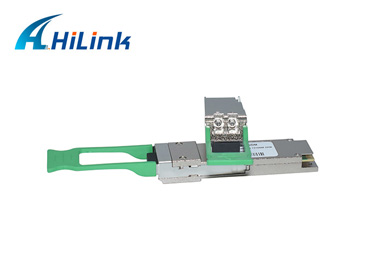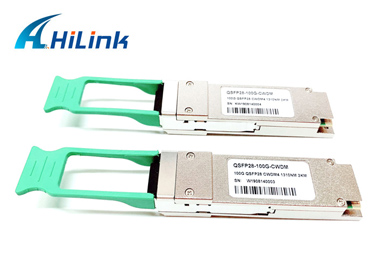100G QSFP28 CWDM4 Optical Module FAQ
Jul. 12, 2022
QSFP28 optical module refers to the 100G optical module in the QSFP28 package, which has become the most popular 100G optical module in data centers and enterprise networks with its small size, low power consumption, and high density.
What is the QSFP28 CWDM4 optical module?
The 100G QSFP28 CWDM4 optical module is a full-duplex, hot-swappable, and photonic integrated optical module that is fully compliant with QSFP MSA, CWDM4 MSA, and IEEE P802.3bm standards. This class of 100G optical modules is equipped with LC duplex connectors and can be used with LC single-mode fiber patch cables for a maximum transmission distance of 2 km. Meanwhile, the 100G QSFP28 CWDM4 optical module adopts Wavelength Division Multiplexing (WDM) technology, which can multiplex four wavelengths on a single fiber for transmission, thus greatly saving fiber resources.
Some people must be confused, 100G QSFP28 LR4 optical module can transmit 10 km, has covered the transmission range of 100G QSFP28 CWDM4 optical module, why not directly use 100G QSFP28 LR4 optical module but choose 100G QSFP28 CWDM4 optical module? This is because the power consumption and laser cost of 100G QSFP28 LR4 optical module are higher than 100G QSFP28 CWDM4 optical module, so it is more economical to choose 100G QSFP28 CWDM4 optical module than 100G QSFP28 LR4 optical module in the transmission range of 2 km.
100G QSFP28 CWDM4
So how does the 100G QSFP28 CWDM4 optical module work?
At the transmitter side, the 100G QSFP28 CWDM4 optical module first converts four electrical signals with a transmission rate of 25Gbps into four CWDM optical signals and then multiplexes them on a single fiber for 100Gbps transmission. At the receiving end, the 100G QSFP28 CWDM optical module first decomposes the optical input signals into four channels of CWDM optical signals and then converts them into four electrical output signals.
100G QSFP28 CWDM4 Optical Module FAQ
Q: When using a pair of 100G QSFP28 CWDM4 optical modules, do I need to turn on the Forward Error Correction (FEC) function?
A: When using 100G QSFP28 CWDM4 optical modules, the FEC function needs to be turned on or off at both ends (the FEC function is turned on to reduce the BER).
Q: What is the main difference between the 100G QSFP28 CWDM4 optical module and the 100G CLR4 optical module?
A: The main difference between the two is whether they support Forward Error Correction (FEC) function or not. For 100G QSFP28 CWDM4 optical modules, it is mandatory to support Forward Error Correction; however, for 100G CLR4 optical modules, Forward Error Correction is optional and it can be enabled to increase link margin or disabled to maintain low latency and low power performance.
100G QSFP28 CWDM4
Q: What is the difference between the 100G QSFP28 CWDM4 optical module and the 100G QSFP28 PSM4 optical module?
A: Both 100G QSFP28 CWDM4 and 100G QSFP28 PSM4 optical modules can transmit signals on four wavelengths. However, the 100G QSFP28 PSM4 optical module uses four independent wavelengths to transmit signals through 8 core MTP/MPO single-mode fiber patch cables. And 100G QSFP28 CWDM4 optical module uses WDM technology to multiplex four wavelengths on a single fiber for transmission, so only 2 core LC duplex single-mode fiber patch cable can be used to achieve 100G transmission.
Q: Is it necessary to clean the connectors of the 100G QSFP28 CWDM4 optical module?
A: Yes, dust and contaminants can accumulate on the connectors of the 100G QSFP28 CWDM4 optical module, potentially causing problems with reduced emitted optical power. To ensure transmission stability, Hilink recommends that you clean the connectors of the optical module each time you disconnect and reconnect.
Q: Will using a third-party compatible 100G QSFP28 CWDM4 optical module on the device have an impact on the warranty policy provided by the manufacturer?
A: No. Network equipment manufacturers do not require you to use original optical modules. When a failure occurs in the network, the manufacturer will continue to provide a warranty policy as long as the failure is not caused by the use of a third-party compatible optical module, provided the equipment is under warranty.













